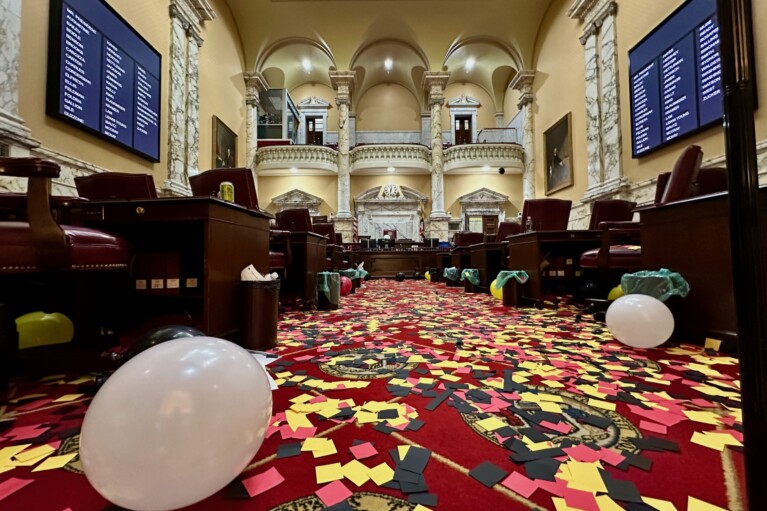Opinion: Do Builders and Developers Still Control Baltimore County?

Builders, developers and their lawyers dominated Baltimore County politics and government during the administrations of former county executives Jim Smith and Kevin Kamenetz. Although the focal point of their influence may have shifted from the county executive’s office to County Council chambers with the election of current County Executive Johnny Olszewski Jr., they still wield enormous power in county affairs.
The most recent manifestation of that power came in the form of the watered-down impact fee bill passed by the Council. Once again ordinary taxpayers came out on the losing end in a contest with builders and developers in Baltimore County. This latest setback could have significant political repercussions because of the way that taxpayers got whipsawed by the County Council.
Taxpayers will see the county income tax rate go from 2.83 percent to 3.3 percent to help eliminate an $81 million budget deficit. The rate increase is expected to yield an additional $33 million in revenue each year.
To ensure that the entire burden of erasing the deficit did not fall upon ordinary taxpayers and that builders and developers paid their fair share, Olszewski proposed Bill No. 23-19. The bill would have produced revenue estimated at $7.7 million per year through an excise tax on new construction.
As it turns out, however, only ordinary taxpayers will be required to uphold their end of the bargain. The council rejected Bill No. 23-19 and passed an alternative bill introduced by Councilmember David Marks, Bill No. 16-19, that was amended practically to death at the urging of builders and developers. Business as usual in Baltimore County.
Political skullduggery vs. ordinary ineptitude
Sometimes in Baltimore County it is difficult to distinguish between political skullduggery and ordinary legislative and legal ineptitude. Bill No. 16-19, as amended and passed by the county council, appears to be a combination of both.
Initial county estimates were that it would generate about $5.7 million per year. The county will not see a full year of revenue from the bill until 2023 because of last-minute amendments to the bill delaying its implementation.
Also, county revenue estimates did not include the effect of numerous credits and exemptions added by those last-minute amendments. The amount of developable land excluded from the scope of the development impact surcharge imposed by the bill alone is so great that the revenue could be far less than $5.7 million per year.
One of the oddest things about Bill No. 16-19 is that it imposes an excise tax and a development impact fee on new construction, depending on the type of construction. The excise tax, called the “development impact surcharge,” is imposed on industrial and commercial construction, including multi-family dwellings. The development impact fee applies to new residential construction, including single-family homes.
Why did the council reject the county executive’s straightforward proposal to impose a development excise tax on both types of construction, residential and non-residential? Certainly at least part of the reason was politics, but there may also have been some confusion at work.
Development impact fees vs. development excise taxes
Senate Bill 451 was sponsored by Sen. Chris West of Baltimore County and enacted into law by the General Assembly this year as Chapter 658 of the 2019 Laws of Maryland. The bill authorizes Baltimore County to adopt a development impact fee.
It is not entirely clear why Mr. West, a Republican, chose to introduce a bill to authorize an impact fee when the county already has the authority to impose a charge on new construction as an excise tax under § 11-1-102(a) of the County Code, a provision enacted by the General Assembly as a public local law for the county in 1953. In 1994, the Maryland Court of Appeals held in a case called Waters Landing v. Montgomery County held that Montgomery County could use similar authority to impose an excise tax on development.
An impact fee is not the same as a development excise tax. Adding to possible confusion is a tendency to refer to the two generically as “impact fees.”

David A. Plymyer
While both are intended to defray the costs of expanding public facilities to accommodate the effect (“impact”) of new construction on those facilities, there are important differences. For the reader interested in a more detailed description of the differences, one is included in the Fiscal and Policy Note prepared for SB 451.
Crafting a charge on new construction as an impact fee rather than as an excise tax has significant legal consequences. A fee system carries substantial administrative burdens and creates opportunities for litigation that simply add costs. Moreover, nothing can be done by imposing the charge as a fee that cannot be done by using a tax.
In fact, there is a technical legal term to describe the decision to use a fee structure when taxing authority is available: That term is foolish. Having said that, if I were a builder or developer, I would prefer a fee because the calculation of a fee is much more vulnerable to challenge in the courts.
The rich get richer
The County Council made a number of dubious decisions in the course of enacting Bill No. 16-19. The one that I am most curious about is suspending the imposition of both the excise tax and the impact fee until Jan. 1, 2021 for development on “land used as a country club for which a concept plan has been submitted and which is located inside the urban-rural demarcation line.” Can I assume that Council members had a particular country club in mind?
The Council also decided to greatly expand the exemptions from the fee and tax. Construction in Enterprise Zones was exempt under the bill proposed by the county executive, but Bill No. 16-19 also exempts construction in Commercial Revitalization Districts and Maryland Opportunity Zones. It is worth noting the developers get property tax credits for construction in revitalization districts and federal tax deductions for construction in opportunity zones.
That means that persons who develop property in those areas will get two tax breaks instead of one. They will get property tax credits or federal tax deductions and receive exemptions from development impact fees and excise taxes.
No evidence was presented that the absence of such exemptions would discourage development in revitalization districts and opportunity zones. That’s another object lesson in how the rich get richer, especially in Baltimore County.
Flawed process leads to flawed result
The amendments that substantially rewrote Bill No. 16-19 were negotiated in a backroom and introduced in the form of a single package to be voted on up or down by the county council. Council rules allowed the Council to vote on the amendments before giving the public a chance to read them, and the amendments and the final bill were passed on the same night that the amendments were made public. So much for openness and transparency.
Council members called the amended bill a “compromise.” A spokesperson for the Maryland Building Industry Association, which long has opposed impact fees, said that “the bill as passed is definitely more balanced and more fair.”
The hastily written amendments are full of loopholes and ambiguities. In my opinion, the amended bill was more of a hatchet job than a compromise. And I don’t believe that the bill was either balanced or fair – at least to ordinary taxpayers.
– David A. Plymyer
The writer is a former county attorney in Anne Arundel County. He can be reached at [email protected]. Twitter: @dplymyer
Did someone forward this to you?
Get your own daily morning news roundup in your inbox. Free. Sign up here.




 Creative Commons Attribution
Creative Commons Attribution